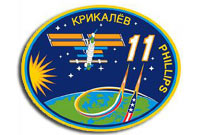NASA Space Station Status Report 22 July 2005

Expedition 11 Commander Sergei Krikalev and Flight Engineer John Phillips got ready this week for two upcoming Space Shuttle launches and a Space Station spacewalk, and supported two different continuing science investigations.
With the 100th day of their six-month mission coming up on July 23, the International Space Station crew members reported in a Friday interview that they are eagerly anticipating Discovery’s arrival next week with tons of supplies, a new experiment rack and a replacement Control Moment Gyroscope (CMG) for the Station’s navigation system. They have been packing equipment that will return home on Discovery to free up much-needed space inside the outpost, and this week they began packing for the STS-121 mission of Atlantis that will follow.
Earlier in the week, Krikalev and Phillips made a short foray in their Soyuz return craft, moving it from the Pirs docking port, which doubles as an airlock for Russian-suit spacewalks, to a Zarya docking port to configure the Station for an August excursion. The pair undocked from Pirs at 5:38 a.m. CDT Tuesday, and smoothly redocked at the nearby Zarya control module’s Earth-facing port at 6:08 a.m. CDT.
The post-Discovery spacewalk by Krikalev and Phillips will involve retrieval of materials exposure experiments, installation of a television camera for the European Space Agency’s cargo-carrying Automated Transfer Vehicle and relocation of a cargo boom adapter.
Phillips supported research this week by setting up a digital still photo camera in the Destiny Laboratory’s window for the continuing EarthKAM student experiment. After the crew mounts the window camera, middle school students research requests for specific geographic targets, and with the help of university students, uplinks commands to a laptop computer connected to the camera. The camera takes pictures at specified times, and the images are downlinked to the ground to be posted on the Internet for the public and participating classrooms around the world. The current EarthKAM run has taken photo requests from 43 schools.
Krikalev spent time setting up and activating a plasma crystal experiment so that it could conduct automated experiments using radio frequency waves to affect crystal formation in microgravity. The experiment is a joint project of the Russian and German space agencies.
Information on the crew’s activities aboard the Space Station, future launch dates, as well as Station sighting opportunities from anywhere on the Earth, is available on the Internet at:
The next Station status report will be issued after STS-114, or on Friday, July 29, if there is a launch delay.








